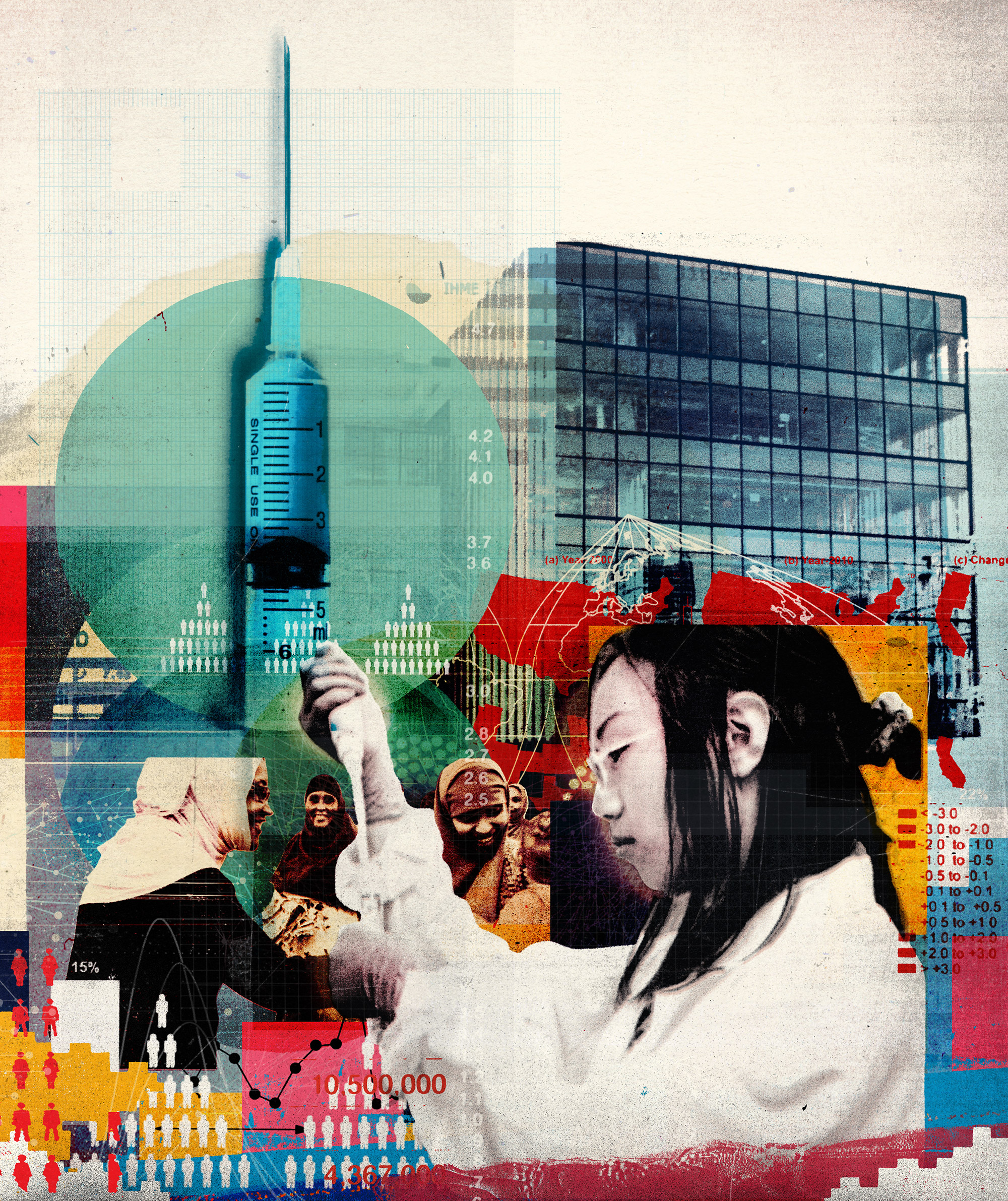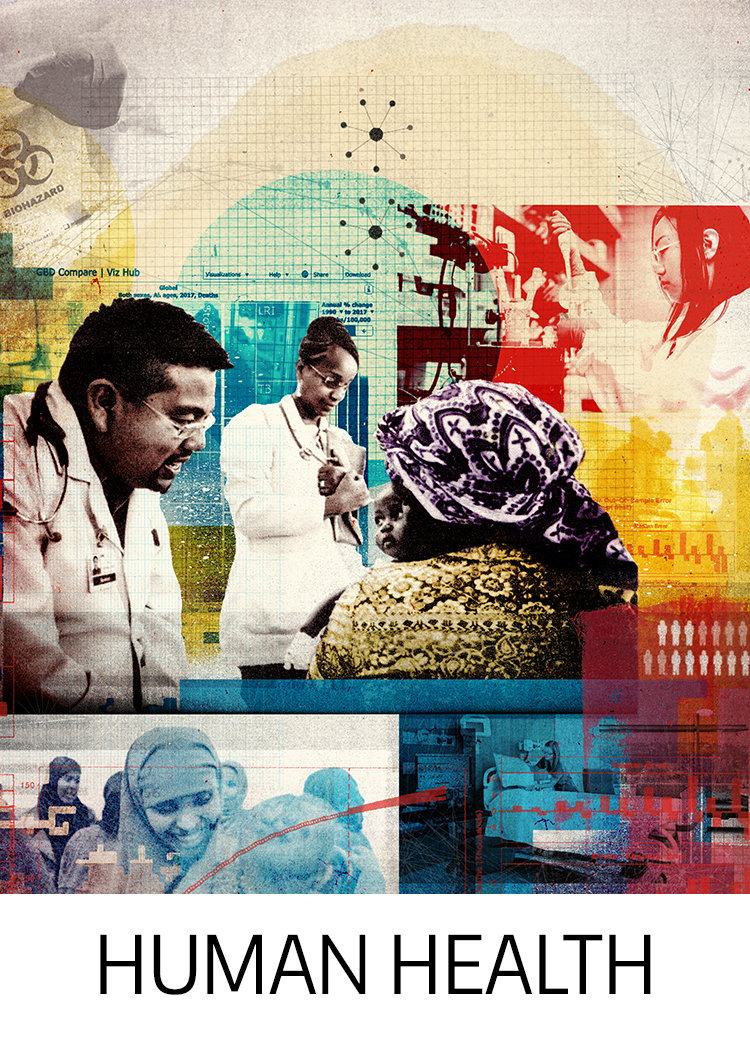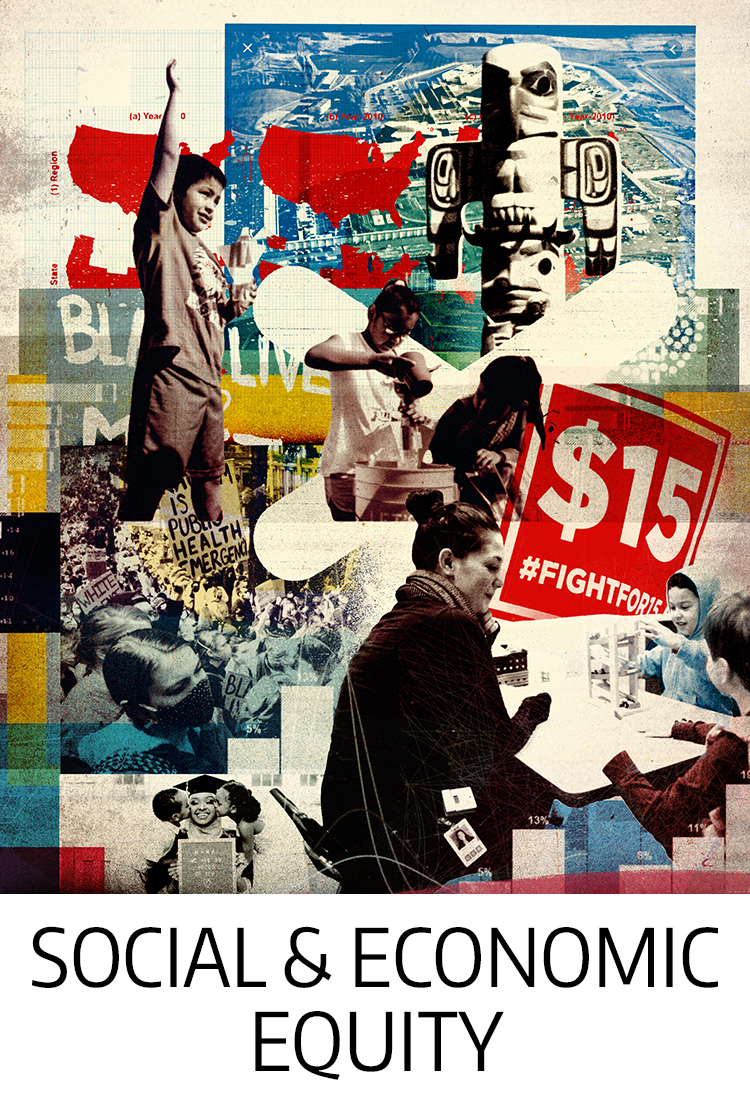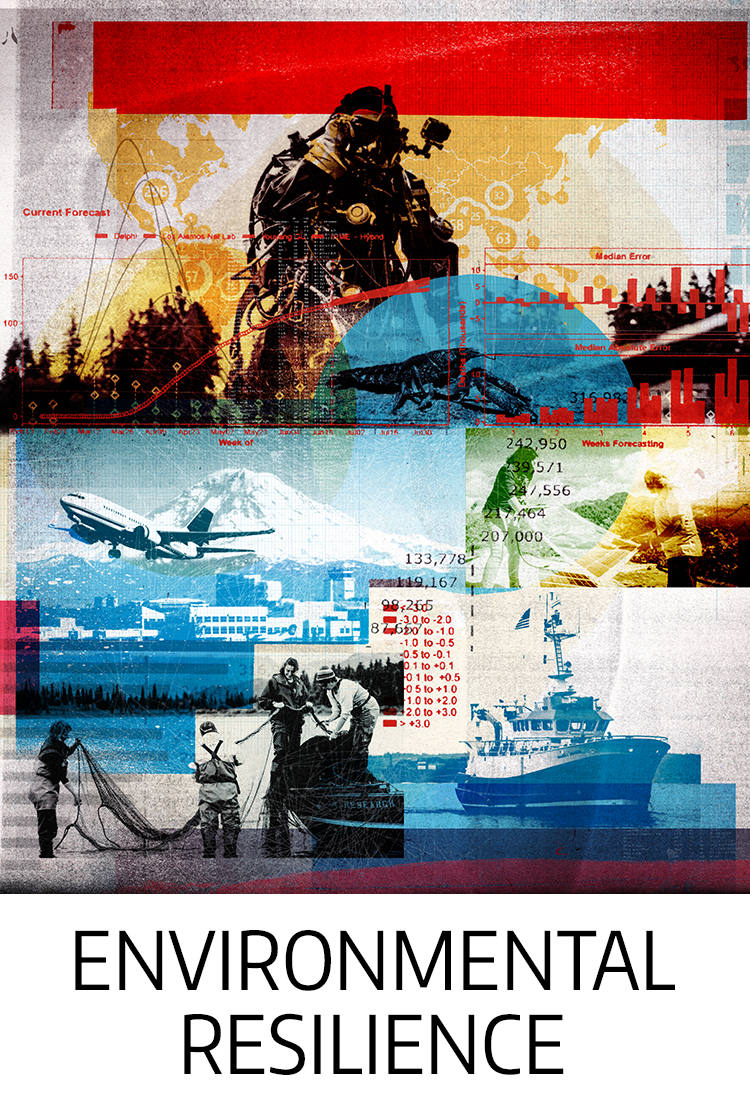For our health For our health For our health
The UW is putting its combined expertise into population health, improving lives around the world.

The UW is putting its combined expertise into population health, improving lives around the world.
As scores of laboratories around the world race to find a vaccine for COVID-19, a few—including two at the University of Washington—are thinking further into the future. One is reporting positive results for their vaccine candidate, and the second is joining in to help figure out how to rapidly develop vaccines for future pandemics.
The critical vaccine work is funded, in part, with a Rapid Response Grant from the UW’s Population Health Initiative. It is one of 20 such grants funding COVID-19 response research across the University. It is also a component of the University’s greater effort to marry its resources and expertise with those of partners in Seattle and around the world working to improve health and quality of life for people everywhere. The work of population health requires complex and cross-disciplinary efforts—from policy and law to scientific research and the practice of medicine—focused not only on the here and now but on the challenges headed our way.
In July, microbiologist Deborah Fuller’s lab reported having a vaccine that produced robust immune responses in animals after just a single dose. Her team is partnering with the lab of fellow UW School of Medicine scientist James Mullins to rapidly develop alternative vaccines to stop future pandemics that might emerge from current and mutated strains of this one.
“I’m hoping that the lessons we learn now are going to be important for us for when the next pandemic strikes,” Fuller says. “As long as there are people and animals living in the world together there will be pandemics.”
Researchers from across the University have been worried about globe-spanning pandemics for decades. They have also understood that social and health inequities, like the ones being exposed by the pandemic, are systemic problems throughout the world, affecting lives for generations. Issues like outbreaks of disease, climate change, clean drinking water, gun violence, a flawed criminal justice system, an expensive and ineffective health-care system—all disproportionately harm vulnerable people and all work against building and supporting healthy populations everywhere.
“As humans, we all share a yearning for a better life, and we now have the opportunity and responsibility to contribute to healthy, productive lives for everyone.”
Ana Mari Cauce, UW President
In 2016, President Ana Mari Cauce decided to magnify the work the University does in these spaces of health, equity and the environment with a Population Health Initiative. Announcing the priority, she placed interdisciplinary collaborations right at the heart of the initiative. Today, core funding from the University and from private philanthropy promotes those collaborations and catalyzes and enhances population health research and community outreach here in the Pacific Northwest, across the country and throughout in the world. “Oceans can’t divide us, and walls and borders offer no defense against diseases that travel the globe,” Cauce says.
The UW’s Population Health Initiative helps bring to campus faculty with a population health focus and an interest in collaboration across fields. It funds student fellowships and provides grants to dozens of collaborative research projects. Because of what it is and because of its location in the Puget Sound region, the UW is at the nexus of education, science, medicine, innovation and philanthropy, ideally placed to do the work of population health. While the Bill & Melinda Gates Foundation leads the world in addressing global health challenges, more than 260 other Washington-based nonprofit organizations and businesses also focus on global health in all 195 countries. They’re helping define and perform the profound work necessary to improve the human condition worldwide.
“Population health is a broader perspective than we often think about when we think about health and medicine,” says Chris Elias, ’90, president of the Gates Foundation’s Global Development Program. “It’s about bringing in the understanding of populations, what makes them healthy, what puts them at risk and then taking steps, some of which happen in the clinic but many of which happen outside a clinic setting.” The University has always been a leader in public health and community medicine and an important influencer in the broader global health around the world, he says. “What I really like about the Population Health Initiative is the interdisciplinary nature of harnessing the entire university for some of the most critical problems facing our society today.”
While a vaccine is key to combating this pandemic, for instance, the effect of the outbreak has been far more profound than the health consequences of infection and the increased demands on health-care systems. It has exposed massive and longstanding health and economic disparities. People from racial and ethnic minority groups are at an increased risk of getting sick and dying from COVID-19, according to the Centers for Disease Control. It cites the reason as “inequities in the social determinants of health, such as poverty and health care access.” They are also faring worse economically.
“As humans, we all share a yearning for a better life, and we now have the opportunity and responsibility to contribute to healthy, productive lives for everyone,” says Cauce. “Our students, whether they study business or social work, international relations or medicine, will have a tremendous impact on the world. This is the right time and the right place.”
Shortly after launching the initiative, Cauce invited Ali Mokdad, a professor at the Institute for Health Metrics and Evaluation (IHME) at the UW School of Medicine, to lead the initiative. Mokdad came to the UW in 2009 after more than a decade working as a senior epidemiologist and branch chief at the Centers for Disease Control and Prevention. He has an expertise in health metrics sciences and is known worldwide for his work on disease trends. “All of the issues we are facing start at home, start in our own communities,” Mokdad says. “And they are not health-related only. They are food-related, job-related, housing-related, and unless we deal with them, we are not going to be a better society.
“No one can do it alone. We have to bring all of our disciplines together.”
Ali Mokdad, professor, Institute for Health Metrics and Evaluation
“If you look at the conditions that we face right now when it comes to population health, there is no one magic solution for it,” he adds. “We have to acknowledge that and accept the fact that no one can do it alone. We have to bring all of our disciplines together to face it and come up with great ideas to be a leader in solving these problems.”
In line with this broad approach, the University established an executive council of about 30 faculty and students from all three campuses to help define the Population Health Initiative. While the UW is a leader in global and public health, the university-wide approach allows “faculty and students in other disciplines see how they can play a role in the health of a population, even though that may not have been part of their original research trajectory,” says India Ornelas, an associate professor in the School of Public Health. She has an expertise in ethnic health disparities and, as part of that executive council, helped shape the early concepts of the initiative.
The work ahead is not only about helping to improve health, environmental and social conditions in significant ways, but also about defining who can contribute, Ornelas says. Who are we training to go back into their communities? How is the UW doing that work in ethical, meaningful and equitable ways? “Students here must have an opportunity to work in the communities they came from so that they see themselves in those careers,” she says. It is key “that they are getting the training they need to go do this important work, that they get a chance to work with the faculty of color who are going to inspire them, and that the faculty of color are supported to do this important community-engaged work.”
To further refine the initiative, the University centered it on three areas: human health, environmental resilience and social and economic equity. Where these areas intersect—where human health is affected by environmental problems that then exacerbate social and economic inequity—that’s where the University wants to be working.
* * *

The immigrant and refugee community in South Seattle is medically underserved and has some of the most negative health outcomes for women and infants, according to King County data. So last year, six faculty from across campus with expertise in anthropology, social work, pediatrics and global health developed a research and outreach project to address gaps in services, language barriers, discrimination and lack of culturally appropriate care-provider services in the community.
Partnering with the Somali Health Board of Tukwila and with funding from the Population Health Initiative, the UW team explored a culturally sensitive health-care outreach. Mama Amaan (Somali for “safe motherhood”) now brings together women at five different locations around South King County for monthly lessons in the physical, mental and emotional issues of pregnancy, childbirth and postpartum life. Now, a year later, the team is building on the success of the local Mama Amaan program with a second project involving community health workers in Puntland, Somalia.
In the years after the launch of the Population Health Initiative, annual calls for proposals for $50,000 research grants have brought together faculty-led teams from fields across campus to study challenges like how fisheries can feed vulnerable populations, how to improve the health of a floating village in the Peruvian Amazon and how to address trauma in war-torn Islamic countries.
The specifically focused research and outreach projects are one end of the population health work. Big data is another. The UW’s Institute for Health Metrics and Evaluation uses real numbers and rigorous analysis to capture the big picture of health, disease and death the world over. The IHME, which has grown to a staff of more than 300, identifies the world’s major health problems and evaluates the strategies used to address them.
The IHME’s Global Burden of Disease project, the largest publishing collaboration in science, helps governments, health leaders, policymakers and others understand a community’s needs. Using the data from the project, they can determine where to put resources to maximize health improvements. Now, during the pandemic, IHME is using its research and data visualization engines to help policymakers and health-care providers in every state in the country understand the potential progression of infections and deaths as well as the looming demands on health care systems from COVID-19.
Because directing the right resources to the right places can save millions of lives, the Bill & Melinda Gates Foundation has committed to invest $279 million to the IHME to expand its work over the next decade.
* * *

About 4.5 million Latinx children are U.S. citizens in mixed-immigration status families. Studies show the status can not only be tied with poor health and development, it can also correlate to limited access to social services. To help change this outcome in Washington, a UW pediatrician, a psychology professor and a director of community partnerships are working together to reach Latinx families and bolster healthy starts for their children. The project involves reaching out to Latinx parents and offering resources to celebrate parenting strengths, address parenting stress and provide access to immigration law resources.
The team’s in-person work has been hampered by the pandemic, says co-lead investigator Elizabeth Dawson-Hahn, an assistant professor in pediatrics. But it’s even more important than ever. COVID-19 has also disproportionately affected Latinx communities. In Washington, for example, roughly 44% of coronavirus cases are from the Latinx community, which makes up 13% of the state’s population.
“All families warrant additional support at this time, and the Latinx community deserves increased support and resources,” says Dawson-Hahn. “The challenges of being concerned about becoming sick with COVID, having family members become sick with COVID, managing the risk of engaging in the workforce—potentially without adequate job protections—and navigating child care and school closures are formidable. Our project is seeking to ensure that community partners and parents from the Latinx community define what strengths and stressors are for their community, and what immigration law resources may be helpful.”
Social and economic inequities and human wellbeing are interlaced. Another component of population health research looks at climate change, which disproportionately affects people of color. Large-scale tropical deforestation, for example, has driven global warming, affecting countries in the equator and southern hemisphere, home to mostly Black, Indigenous, Latinx and Asian people. But climate change is disproportionately harming people in the northern hemisphere, as well. According to one recent UW study, agricultural workers in the United States are exposed to more days of extreme heat than they were just a few years ago. Since nearly 65 percent of American farmworkers are Hispanic, according to U.S. Department of Agriculture counts, this community is disproportionately affected.
“The climate science community has long been pointing to the global south, the developing countries, as places that will be disproportionately affected by climate change,” says David Battisti, professor of atmospheric sciences. “This work shows that you don’t have to go to the global south to find people who will get hurt with even modest amounts of global warming—you just have to look in our own backyard.”
* * *

The marbled crayfish first appeared in Madagascar’s lakes, ponds and streams in 2005. Since then, the crustacean’s range has spread across an area of 100,000 kilometers and now poses a serious threat to the environment as well as to agricultural production in the region.
But the news isn’t all negative for the people of Madagascar. The crayfish offers a benefit by consuming snails that transmit schistosomiasis, a disease that infects human digestive systems. The crayfish could also become a renewable protein source for the country, where over half the children are malnourished.
To help the country make evidence-based action plans, a UW team funded by a Population Health grant is working with Madagascar’s Ministry of Health and an international organization that helps alleviate the spread of diseases like schistosomiasis. The Malagasy government can use the results of the study to decide how to manage the marbled crayfish to minimize impacts on local biodiversity while maximizing benefits to public health.
Assistant Professor Chelsea Wood says her lab in the School of Aquatic and Fishery Science is forging ahead with the research, despite not being able to travel to the country because of the pandemic. “We’ve been working with our Malagasy partners and are now providing full support for them to run the first phase of sampling without us,” Wood says. “We’re hoping to be able to join them on the ground soon. Ultimately, we aim to evolve these initial efforts into a large, multi-year, multi-institutional project, and we would not have been able to take the first steps toward that goal without [funding] support from the Population Health Initiative and EarthLab [a UW environmental institute].”
Closer to home, scientists and students in the Department of Environmental & Occupational Health Sciences are working with neighborhood and governmental organizations to study air pollution at SeaTac Airport. The UW’s Mobile ObserVations of Ultrafine Particles study reported high levels of ultrafine particle pollution in certain neighborhoods. “We found that communities under the flight paths near the airport are exposed to higher proportions of smaller-sized, ‘ultra-ultrafine’ pollution particles and over a larger area compared to pollution particles associated with roadways,” says Associate Professor Edmund Seto.
But the study, the results of which can be used in airport neighborhoods around the world, isn’t just about the environment. Other research has linked exposure to ultrafine particles to breast cancer, heart disease, prostate cancer and a variety of lung conditions. “We can now study the specific health effects of aircraft-related pollution, how different neighborhoods may be affected by it and specific interventions that could reduce human exposure to these pollutants,” adds Professor Michael Yost, who collaborated on the study. “We hope to work with state and local policymakers as well as affected communities to pursue these questions.”
Next month, with a very small celebration that includes a few online lectures, the University will dedicate the new Hans Rosling Center for Population Health. The 290,000-square-foot building sits on the west side of campus. It is funded, in part, with a $210 million gift from the Bill & Melinda Gates Foundation, and designed for the mission of the Population Health Initiative. It is a new home for the Institute for Health Metrics and Evaluation, the UW’s Global Health Department and the School of Public Health. While those organizations have begun moving into the building, full occupation depends on progress against the pandemic.
The center will be a place for students to collaborate with researchers and others from across campus, and where public health and service organizations from around the world can meet to address the most persistent and emerging challenges to human health, environmental resilience and social and economic equity across the globe.
“I think the building, and particularly how the building has been designed, creates a crossroads for students and faculty of many different disciplines to interact around an important health problem,” Elias of the Gates Foundation says. “There was a tremendous amount of interest in the initiative (around the Seattle health ecosystem) when Ana Mari announced it. And there will be more interest as the building comes on line.”